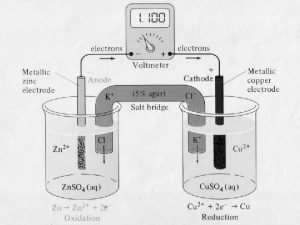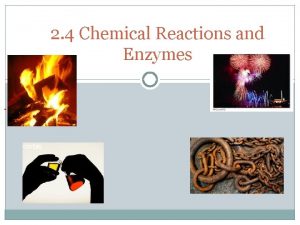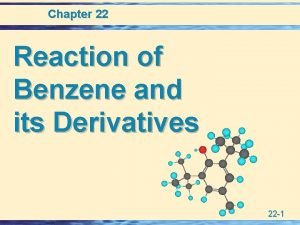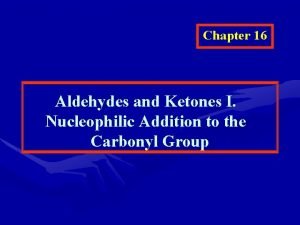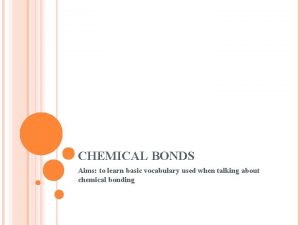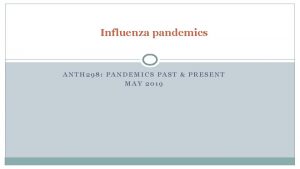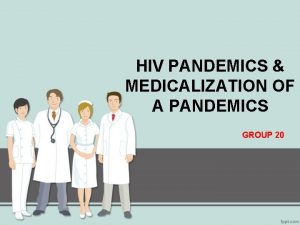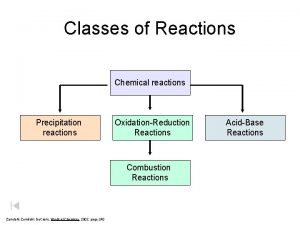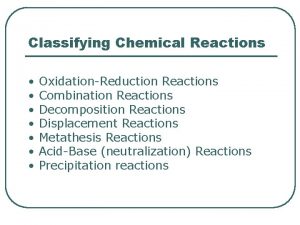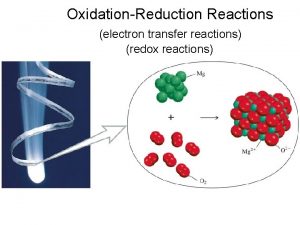Pandemics and Reactions An Overview and Analysis Pandemics


















































- Slides: 50

Pandemics and Reactions An Overview and Analysis

Pandemics and Reactions What We Will Talk About: • Part One: What is a Pandemic? o o o Pandemic Defined Why are Pandemics Scary? What Causes Pandemics: Diseases, Transmission and Virulence Defense Against Pandemics – Immunity Forces to Fight Pandemics • Part Two: Pandemics in History o Pioneers in Medicine o Past Pandemics • Part Three: How to Address a Pandemic o o Prevention Response Recovery Entities Responsible for Addressing A Pandemic • Part Four: The Coronavirus Pandemic of 2019 -20 o o o o Facts About the Coronavirus Ground Zero Wuhan China Coronavirus 2019 -20 Pandemic Statistics Coronavirus 2019 -20 Pandemic Federal Action Team Coronavirus 2019 -20 Pandemic State Action Team Coronavirus 2019 -20 Pandemic Action Timeline Coronavirus 2019 -20 Pandemic Final Thoughts

Part Two - Pandemics in History

Pioneers of Modern Medicine Edward Jenner (1749 -1823): Vaccines British surgeon and naturalist Edward Jenner developed the first vaccine, the smallpox vaccine, in 1796. Jenner was inspired to develop the practice of vaccination after noticing that milkmaids who caught the disease cowpox never developed smallpox. Jenner inoculated the son of his gardener with cowpox, and the boy failed to develop smallpox after being exposed repeatedly to infected smallpox material. This first vaccine laid the foundations for the field of immunology.

Pioneers of Modern Medicine Louis Pasteur (1822 -1895): Germ Theory Among his many claims to fame, French chemist and microbiologist Louis Pasteur was the first scientist to support the germ theory of disease, the idea that diseases are caused by microorganisms, with his research. Pasteur expended a lot of effort investigating what agents caused beverages like milk and wine to spoil, inventing his eponymic process “pasteurization” in the process. After discovering that microbes were responsible for sour wine and spoiled milk, Pasteur hypothesized that microbes also caused disease in the body. He later supported this theory in the mid 1860 s by showing that a malady attacking silkworms in Alais, France, was caused by microbes attacking silkworm eggs.

Pioneers of Modern Medicine Joseph Lister (1827 -1912): Antiseptic surgery British surgeon Joseph Lister is best known for applying Louis Pasteur’s work in microbiology to pioneer antiseptic surgery. At the University of Glasgow in the 1860 s Dr. Lister experimented with wound treatment with carbolic acid, then used to treat sewage, using Pasteur’s studies of the germ theory of disease to guide his work. After successfully proving that carbolic acidbased sterilization of wounds reduced gangrene, Dr. Lister went on to promote handwashing and surgical instrument sterilization as a means of reducing infection. His legacy in sterilization is also evident in the naming of a bacteria genus, a slime mold genus and Listerine, all of which are his namesakes.

Pioneers of Modern Medicine William Osler (1849 -1919): Specialty Residency and Medical Training Canadian physician William Osler is known as the “father of modern medicine. ” One of the founders of Johns Hopkins Hospital in Baltimore, Md. , Osler created the first specialty training residency program / medical school. He was also the first to put medical students through formalized bedside clinical training. In addition to his medical career, Osler was also a historian and an author.

Pioneers of Modern Medicine Florence Nightingale (1820 -1910): Nursing Florence Nightingale, social reformer, statistician and healthcare pioneer, was the founder of modern nursing. The British native’s claim to fame came during the Crimean War in 1854, when she and 38 other women were sent to minister to British soldiers. Finding an unhygienic, short-staffed hectic camp, Nightingale and her team reduced the death rate by 42 percent to 2 percent. A fund to train nurses for the war was established in her name in 1855. Nightingale went on to found a nursing school, write several texts on nursing and contribute to modern statistical analysis of sanitary reform.

Pioneers of Modern Medicine Richard Lawler (1896 -1982): Organ transplants Richard M. Lawler, MD, is best known for performing the first successful internal organ transplant, a kidney. He performed the transplant in 1950 in Chicago at Little Company of Mary Hospital. His patient was a 49 -year-old Ruth Tucker, who suffered from polycystic kidney disease. The transplant was successful, though Ms. Tucker died from other causes five years later. While Dr. Lawler never performed another kidney transplant, his success paved the way for others to see the possibility of organ transplant as a viable treatment option.

Pioneers of Modern Medicine Forest Bird 8. Forrest M. Bird (b. 1921): Ventilator Forrest M. Bird, MD, Ph. D, Sc. D, is an American pilot and inventor best known for creating the first reliable mechanical ventilators which are used in cardiopulmonary care. Dr. Bird began his career as a pilot, making his first solo flight at the age of 14 and earning his first aviation license at 16. By the time he enrolled in the Air Force at in 1941, he was qualified to be a technical air training officer. This qualification allowed Dr. Bird to fly nearly every plane the Air Force had to offer, including several that exceeded comfortable breathing altitudes. This experience prompted him to inventilation aids. In 1955 his work resulted in the release of the Bird Universal Medical Respirator, a pneumatic ventilator that is still in use around the world today.

Pioneers of Modern Medicine Francis Crick (1916 -2004): Molecular biology Known most famously for being one of the four researchers who determined the doublehelix structure of DNA, Francis Crick, Ph. D, is also a leader of the research team that discovered DNA is made of codons - amino acid triplets, that carry and encode genetic information. As a result of this late-1950 s discovery, another research team was able to decipher the genetic code. This uncracking of the genetic code, had led to the birth of molecular biology and the understanding of the role genetics plays in human variation and health.

TERRIBLE PANDEMICS IN HISTORY

Plague of Athens (430 B. C. ) Typhoid � Occurred during the Peloponnesian War between Sparta and Athens. � First recorded pandemic in history. � Killed over a quarter of Athens troops and up to 2/3 of Athens population (estimated 100, 000). � The cause was unknown until 2006, where university researchers analyzed teeth of the dead and found typhoid bacteria.

Plague of Athens (430 B. C. ) Typhoid Cause: • An bacterial intestine/blood infection caused by Salmonella. Symptoms: • Beginning 6 to 30 days after exposure; • High Fever; • Weakness/Fatigue; • Abdominal Pain/Constipation/Vomiting; • Headaches; • Skin rash. Duration: • Without treatment, symptoms can last weeks or months. Virulence: • Without treatment/antibotics – Fatality rate is 10 to 20 percent. • Asymptomatic carriers can spread the disease to others Spread: • Eating or drinking food or water contaminated with the feces of an infected person.

Plague of Athens (430 B. C. ) • Thucydides described the disease as such "People in good health were all of a sudden attacked by violent heats in the head, and redness and inflammation in the eyes, the inward parts, such as the throat or tongue, becoming bloody and emitting an unnatural and fetid breath. Next came coughing, diarrhea, spasms, and skin ulcers. A handful survived, but often without their fingers, sights, and even genitals!” • How we would treat it today: Ø Vaccinate against the toxin produced by the typhoid (salmonella) bacteria. Ø Fluid replacement. Ø Antibiotics like tetracycline. • These treatments would reduce the chance of death to close to zero.

The Antonine Plague (165 -180 A. D. ) Small Pox / Measles � Roman troops returning from battles in the middle east brought back with the spoils of war, smallpox and measles. � It decimated the population of Rome and is thought to be the single greatest cause of the weakening of the Roman Empire in Northern and Eastern Europe. � Killed the last great Roman Emperor, Marcus Aurelius Antoninius. � It killed one quarter of those infected. (estimated 5 million).

The Antonine Plague (165 -180 A. D. ) Small Pox Cause: • Highly contagious, viral variant infection caused by Variola Major/Minor. Symptoms: • Beginning 10 to 14 days after infection; • Fever; • Vomiting; • Back Pain; • Fatigue; • Mouth Sores/Skin Rash; • Fluid-filled Bumps on the Skin, Which Scab, Fall Off, and Leave Scars. Duration: • Days to Weeks Virulence: • Fatality rate is typically 30%, with higher rates among babies. • Survivors often suffer extensive scarring, with a small number left blind. Spread: • By Personal Contact or Contaminated Objects

The Antonine Plague (165 -180 A. D. ) Measles Cause: A highly contagious, viral infection caused by the Measles Virus. Symptoms: • Beginning 10– 12 days after exposure to an infected person; • High Fever; • Cough; • Runny Nose/Congestion/Inflamed eyes; • Small, White Spots inside the Mouth; • Red, Flat Face Rash that Spreads to the Rest of the Body. Duration: • 7 to 10 Days Virulence: • Without treatment – Fatality rate is 10 to 20 percent (mostly children) • Complications: diarrhea, ear infection or pneumonia. • Serious complications: seizures, blindness, or brain inflammation. • Most people do not get the disease more than once. Spread: • Airborne/droplet transmission through coughs/sneezes of infected people, or through direct contact with mouth or nasal secretions, or surfaces on which the virus is residing. • Extremely contagious, 90% of non-immune people who share living space with an infected person, will also become infected.

The Antonine Plague (165 -180 A. D. ) The famous Greek physician Galen described it as “a long, cruel disease that involved fever, diarrhea, and inflammation of the throat, as well as pustules on the skin”. • How we would treat it today: Ø Small Pox Vaccine. Ø Measles Vaccine. Ø Anti Viral Drugs such as Cidofovir. • Thankfully due to wide spread vaccination programs small pox has been eradicated all over the world since 1979. • The only remaining samples of the small pox virus exist today in high level medical research labs such as USAMRID (United States Army Medical Research Institute of Infectious Diseases. • Sadly measles does still exist, and outbreaks do still continue to happen, although it has been severely limited due to vaccines.

The Justinian Plague (541 -542 A. D. ) Bubonic Plague The Byzantine Empire, which imported most of its grain from Egypt, in order to feed its people, also imported with it, the Bubonic Plague (caused by the Bacteria Yserina pestis). This plague killed between 5, 000 to 10, 000 people a day. It eventually killed up to 40% of Constantinople’s population and by the year 700 A. D. , killed up to 60% of Europe’s population (estimated 50 million).

The Justinian Plague (541 -542 A. D. ) Bubonic Plague: • A bacterial blood/lymph node infection caused by yserina pestis bacteria. Symptoms: • Beginning 1 to 7 days after exposure; • Fever; • Headaches; • Vomiting; • Swollen and Painful Lymph Nodes, which may break open. Duration: • 10 Days Virulence: • Without treatment/antibiotics – Fatality rate is 30 to 90 percent. Spread: • By infected fleas whose bite transmits the bacteria, or • By exposure to the body fluids of a plague-infected animal or person.

The Justinian Plague (541 -542 A. D. ) The Byzantine historian Procopius first reported the epidemic in 541, stating that at its peak the plague was killing 10, 000 people in Constantinople daily. He further noted that because there was no room to bury the dead, bodies were left stacked in the open, with the entire city smelling like the dead. In his Secret History, he records the devastation, stating: “When pestilence swept through the whole known world and notably the Roman Empire, wiping out most of the farming community and of necessity leaving a trail of desolation in its wake, Justinian showed no mercy towards the ruined freeholders. ” • How we would treat it today: Ø Antibiotics like streptomycin and tetracycline. Ø 85% of today’s cases are curable. • Thankfully today, due to antibiotics, Bubonic Plague is not the deadly killer it was in the past

The Black Death (1347 -1351 A. D. ) Bubonic Plague This was the most famous and deadly pandemic in Earth’s history. It killed between 30 -60% of Europe’s population. (estimated 200 million). Once arriving in western Europe via merchant ships, it spread rampantly from city to city creating widespread terror and panic. Victims broke out in large, oozing pustules, vomited profusely, coughed up blood, and contracted other conditions such as necrosis and gangrene. 80 percent of victims died within eight days,

The Black Death (1347 -1351 A. D. ) Bubonic Plague: • A bacterial blood/lymph node infection caused by yserina pestis bacteria. Symptoms: • Beginning 1 to 7 days after exposure; • Fever; • Headaches; • Vomiting; • Swollen and Painful Lymph Nodes, which may break open. Duration: • 10 Days Virulence: • Without treatment/antibiotics – Fatality rate is 30 to 90 percent. Spread: • By infected fleas whose bite transmits the bacteria, or • By exposure to the body fluids of a plague-infected animal or person.

The Black Death (1347 -1351 A. D. ) According to medieval historian Philip Daileader, it is likely that over four years, 45– 50% of the European population died of the plague. Italian chronicler Agnolo di Tura recorded his experience from Siena: “Father abandoned child, wife husband, one brother another; for this illness seemed to strike through the breath and sight. And so they died. And none could be found to bury the dead for money or friendship. Members of a household brought their dead to a ditch as best they could, without priest, without divine offices. . . great pits were dug and piled deep with the multitude of dead. And they died by the hundreds both day and night. . . And as soon as those ditches were filled more were dug. . . And I, Agnolo di Tura. . . buried my five children with my own hands. ” • How we would treat it today: Ø Antibiotics like streptomycin and tetracycline. Ø 85% of today’s cases are curable. • Thankfully today, due to antibiotics, Bubonic Plague is not the deadly killer it was in the past

New World Small Pox (1633 - 1800 A. D. ) Small Pox became one of the deadliest killers in the New World. Between Colonists and Native Americans, the small pox virus widely killed and disfigured (an estimated 56 Million). By 1723, Boston alone, had seen four epidemics of smallpox alone. Three out of every ten contracted the disease died. who Starting in 1721 inoculation, the process of purposefully infecting a person with small pox by means of passing a needle with the pus of a victim and transferring it to a healthy individual became an accepted medical practice.

New World Small Pox (1633 - 1800 A. D. ) Small Pox Cause: • Highly contagious, viral variant infection caused by Variola Major/Minor. Symptoms: • Beginning 10 to 14 days after infection; • Fever; • Vomiting; • Back Pain; • Fatigue; • Mouth Sores/Skin Rash; • Fluid-filled Bumps on the Skin, Which Scab, Fall Off, and Leave Scars. Duration: • Days to Weeks Virulence: • Fatality rate is typically 30%, with higher rates among babies. • Survivors often suffer extensive scarring, with a small number left blind. Spread: • By Personal Contact or Contaminated Objects

New World Small Pox (1633 - 1800 A. D. ) George Washington survived Small Pox as a teenager in Barbados, and he, as well as Ben Franklin, Alexander Hamilton and Thomas Jefferson were fierce advocates for inoculation. During the Revolution small pox caused devastating losses to the Colonial Army, including stopping its invasion of Canada in 1775 and 1776, and in its winter encampment at Valley Forge during 1777. • How we would treat it today: Ø Small Pox Vaccine. Ø Anti Viral Drugs such as Cidofovir. • Thankfully due to wide spread vaccination programs small pox has been eradicated all over the world since 1979. • The only remaining samples of the small pox virus exist today in high level medical research labs such as USAMRID (United States Army Medical Research Institute of Infectious Diseases.

Cholera (1816 - 1896 A. D. ) Cholera There were five major cholera pandemics, during the 19 th century (killing an estimated 1 million people). Untreated victims died within as little as 3 hours of the first symptoms, literally of fluid loss due to acute diarrhea, which was accompanied by vomiting, cramps and lowered blood pressure. In Chicago in 1854, Cholera killed 5% of the city’s population. The 1853 London outbreak was stopped when physician John Snow discovered its source to be a waterpump contaminated by the feces of other cholera victims.

Cholera (1816 - 1896 A. D. ) Cholera Cause: • An bacterial intestine/blood infection caused by Vibrio Cholerae. Symptoms: • Beginning 2 hours to 5 days after exposure; • Severe Diarrhea; • Muscle Cramps; • Vomiting; • Sunken Eyes; • Cold Skin. Duration: • Three to Five Days. Virulence: • Without treatment/antibotics – Fatality rate is 15% (mostly seniors). • Asymptomatic carriers and infected can spread the disease to others Spread: • Eating or drinking food or water contaminated with the feces of an infected person.

. Cholera (1816 - 1896 A. D. ) Cholera caused more deaths, more quickly, than any other epidemic disease in the 19 th century. Cholera, an exclusively a human disease, is transmitted through fecal-contaminated waters and contaminated foods. Contemporary English doctors published the following description of the disease's symptoms and onset: “Giddiness, sick stomach, nervous agitation, intermittent, slow, or small pulse, cramps beginning at the tops of the fingers and toes, and rapidly approaching the trunk, give the first warning. Vomiting or purging, or both these evacuations of a liquid like rice-water or whey, or barley-water, come on; the features become sharp and contracted, the eye sinks, the look is expressive of terror and wildness; the lips, face, neck, hands, and feet, and soon after the thighs, arms, and whole surface assume a leaden, blue, purple, black, or deep brown tint according to the complexion of the individual, varying in shade with the intensity of the attack. ” • How we would treat it today: Ø Antibiotics like streptomycin and tetracycline. Ø Fluid Replacement. • Thankfully today, when treated properly the death rate is now less than 1 percent of victims.

Spanish Flu (1918 - 1920 A. D. ) Influenza A (Spanish) During the height of World War I, a shockingly virulent strain of Influenza-A swept the world, quickly spreading to all regions all across the globe (killing an estimated 50 million people). Whereas most flu epidemics affect only weaker populations, such as infants or the elderly, the 1918 Flu involved a virus mutation that allowed it to overtake the immune system and turn it against the victim’s body. This resulted in a much higher mortality rate among the otherwise young and healthy, whose immune systems were stronger, as well as a devastating toll on social productivity.

Spanish Flu (1918 - 1920 A. D. ) H 1 N 1 - Influenza - A Cause: • A highly contagious, viral infection caused the H 1 N 1 Influenza A virus. Symptoms: • Beginning 1 to 4 days after infection; • Headache; • Fatigue; • Dry, Hacking Cough; • Runny Nose/Congestion; • Stomach Ache, Loss of Appetite; • Respiratory Distress/Shortness of Breath. Duration: • 3 to 10 days Virulence: • Fatality rate was typically 3%, with higher rates among young adults. • Known to trigger a Cytokine Storm (a hyper active immune response). Spread: • Airborne/droplet transmission through coughs/sneezes of infected people, or through direct contact with mouth or nasal secretions, or surfaces on which the virus is residing. • Extremely contagious, nearly one third of the globe (an estimated 500 million people) became infected.

Spanish Flu (1918 - 1920 A. D. ) Everyday life stopped, schools and shops closed, and even gravediggers were too sick to bury the dead. In some cases, mass graves were dug using steam shovels, and bodies were buried without coffins. This pandemic infected nearly one third of the world’s population (600, million people), and reportedly caused between 50 million and 100 million deaths – more than all the wars of the 20 th century combined. World War One stopped in large part due to this pandemic. With no vaccine to protect against influenza infection, and with no antibiotics to treat secondary bacterial infections, control efforts worldwide were limited to non pharmaceutical measures, such as isolation, quarantine, good personal hygiene, disinfectants, and limitations of public gatherings. • How we would treat it today: Ø Antivirals like Tamiflu and Relenza Ø Proper Hygiene. • This was the first Swine Flu (H 1 N 1 virus) pandemic in recorded history and the first pandemic in the age of modern medicine.

Polio (1930 - 1955 A. D. ) Poliomyelitis Throughout the first half of the 20 th century, the polio virus arrived each summer, striking without warning. No one knew how it was transmitted or how it was caused. In 1952, the number of polio cases in the U. S. peaked at 57, 879, resulting in 3, 145 deaths. Those who survived this highly infectious disease, could end up with a form of paralysis, forcing them to use crutches, wheelchairs or to be put into an iron lung (a large tank respirator for breathing). Ultimately, poliomyelitis was conquered in 1955. A vaccine was developed by Jonas Salk and his team at the University of Pittsburgh.

Polio (1930 - 1955 A. D. ) Polio Cause: • A contagious, viral infection caused the poliomyelitis virus. Symptoms: • Beginning 6 to 20 days after infection; • Fever; • Sore Throat; • Fatigue; • Stomach Pain/Vomiting; • Pain/Stiffness in Back, Neck, Limbs and/or Diaphragm. Duration: • 3 to 10 days Virulence: • Fatality rate - 30 percent among adults, far less with children. • Asymptomatic carriers (nearly 70% of infected) can spread the disease to others. Spread: • Present in saliva and intestines of infected individuals, it is spread from person to person, by food or water containing human feces, and less commonly from infected saliva. • Years after recovery, persons originally infected, can experience postpolio syndrome, with reoccurring symptoms similar to initial onset.

Polio (1930 - 1955 A. D. ) Polio became a cause celeb disease in the United States from the 1930’s to the 1950’s owing principally to the fact that President Franklin Roosevelt was a survivor, and in that it was so debilitating to children. Although many people fully recover, in those with muscle weakness, up to 5% percent of children, and up to 30% of adults, die of the disease. 25% of people infected suffer only minor symptoms (fever / sore throat) and up to 5% experience a headache, and/or neck, leg and arm pains. The cause to cure polio created the famous charity the March of Dimes in 1938. After funding the successful research that led to the development of a vaccine by Jonas Salk, the organization expanded its focus to fund research and treatments for childhood birth defects. • How we would treat it today: Ø Vaccine for Prevention Ø Treatment for relief of symptoms, speed recovery and prevent complications. Also antibiotics to prevent ancillary infections and analgesics for pain.

HIV - AIDS (1981 to Present A. D. ) Human Immunodeficiency Virus Believed to have originated in Africa, (HIV/AIDS), first identified in 1981, is a spectrum of conditions caused by infection with the human immunodeficiency virus. Initial infection is often asymptomatic, or accompanied by a brief period of influenza-like illness. If the infection progresses, it interferes with the immune system, manifesting in common opportunistic infections, and tumors which are otherwise rare in people who have normal immune function. Late symptoms of infection are referred to as Acquired Immunodeficiency Syndrome (AIDS), and are often associated with unintended weight loss. (Since discovery an estimated 35 million have died of AIDS worldwide). HIV is spread primarily by unprotected sex, contaminated blood transfusions, hypodermic needles, and from mother to child during pregnancy, delivery, or breastfeeding. HIV is a member of the group of viruses known as retroviruses.

HIV - AIDS (1981 to Present A. D. ) HIV - AIDS Cause: • A viral infection caused the human immunodeficiency (retro) virus, which over time can transform into acquired immunodeficiency syndrome. Symptoms: • Beginning 2 to 4 weeks after infection; • Fever; • Lymph Node/Throat Inflammation; • Fatigue/Headache; • Rash/Genital and/or Mouth Sores; • Gastrointestinal Distress. Duration: • Lifetime Disease, but if untreated into AIDS – Survival for 11 years. Virulence: • Fatality rate – 100% if untreated into AIDS – Treated: Normal Lfespan. • Asymptomatic carriers (HIV had to detect if untested) can spread the disease to others. Spread: • HIV is spread by three main ways: o Sexual contact; o Significant exposure to infected body fluids or tissues; and o From mother to child during pregnancy, delivery, or breastfeeding

HIV - AIDS (1981 to Present A. D. ) Since the start of the pandemic, an estimated 79 million people have been infected with HIV, world wide, and 35 million have died from the disease. Presently, globally, about 38 million people are currently living with HIV, approximately 2 million people are annually infected, and about 770, 000 people die every year of the disease. In the United States it is estimated that 1. 1 million people are living with the disease, with 37, 000 new infections, and 16, 000 deaths annually. Starting in the early 21 st century, the annual number of new infections began to decrease, and since 2005 the annual number of AIDS-related deaths globally has also begun to decline. • How we would treat it today: Ø Prevention strategies include use of condoms during sexual activity, avoidance of contaminated needles or blood transfer and HIV prevention medications such as as pre-exposure prophylaxis (Pr. EP) and post-exposure prophylaxis (PEP). Ø Treatment for HIV involves taking medicines that slow the progression of the virus in the body. Such involves the combination of drugs known as antiretroviral therapy (ART). These medications include Nucleoside and Nucleotide Reverse Transcriptase Inhibitors (NRTIs), Non-nucleoside Reverse Transcriptase Inhibitors (NNRTIs) and Protease Inhibitors (PIs)

Swine Flu (2009 - 2010 A. D. ) Influenza (H 1 N 1) In the spring of 2009, a novel influenza A (H 1 N 1) virus emerged. It was detected first in the United States and spread quickly across the world. This new H 1 N 1 virus contained a unique combination of influenza genes not previously identified in animals or people. Few young people had any existing immunity the virus, but nearly 1/3 of people over 60 had antibodies against it (likely from exposure to an older H 1 N 1 virus). From April 12, 2009 to April 10, 2010, the Center for Disease Control estimated there were 60. 8 million cases of infection, 274, 304 hospitalizations, and 12, 469 deaths in the United States due to the virus.

Swine Flu (2009 - 2010 A. D. ) H 1 N 1 - Influenza - A Cause: • A highly contagious, viral infection caused the H 1 N 1 Influenza A virus. Symptoms: • Beginning 1 to 4 days after infection; • Headache; • Fatigue; • Dry, Hacking Cough; • Runny Nose/Congestion; • Stomach Ache, Loss of Appetite; • Respiratory Distress/Shortness of Breath. Duration: • 3 to 10 days Virulence: • Fatality rate is typically 3%, with higher rates among young adults. • Known to trigger a Cytokine Storm (a hyper active immune response). Spread: • Airborne/droplet transmission through coughs/sneezes of infected people, or through direct contact with mouth or nasal secretions, or surfaces on which the virus is residing. • Extremely contagious.

Swine Flu (2009 - 2010 A. D. ) Analysis of the genetic divergence of the virus in samples from different cases indicated that the virus jumped to humans in 2008, probably after June, and not later than the end of November. A report by researchers at the Mount Sinai School of Medicine found that the 2009 H 1 N 1 virus likely originated from pigs in a very small region of central Mexico. The initial response by the Federal Government proved less than effective. During the summer of 2009, the CDC attempted to reform the public health safety net before flu season started up again in early autumn. Such reforms included planning a second influenza vaccination program, in addition to the one for seasonal flu, and improving coordination between federal, state, and local governments and private health providers. In October 2009, U. S. President Obama declared swine flu a national emergency. • How we would treat it today: Ø A new H 1 N 1 vaccine was developed in October 2009, but previous flu vaccines proved ineffective. Ø Antivirals like Tamiflu and Relenza (although some mutated strains demonstrated resistance to Tamiflu) Ø Proper Hygiene.

Ebola (2014 - 2016 A. D. ) Ebola Virus Disease Ebola, is a viral hemorrhagic fever, which originated from Africa. A recent outbreak in 2014 killed an estimated 11, 000 people. Control of outbreaks requires coordinated medical services and community engagement, including rapid detection, contact tracing of the exposed, quick access to laboratory services, care for those infected, and proper disposal of the dead through immediate cremation or burial. Some strains kill 90% of those who are infected. Prevention includes limiting the spread of disease, wearing proper protective clothing and washing hands when around a person with the disease. An Ebola vaccine was approved in the United States in December 2019.

Ebola (2014 - 2016 A. D. ) Ebola Cause: • A highly contagious, viral, hemorrhagic fever, infection caused by the ebola virus. Symptoms: • Beginning 2 to 21 days after infection; • Fever; • Sore Throat; • Muscular Pain, and Headaches; • Vomiting/Diarrhea; • Rash; • Decreased Liver and Kidney Function; • Internal and External Bleeding. Duration: • 6 to 16 days Virulence: • Fatality rate is typically 25% to 90%, depending on the virus strain. • Causes extreme low blood pressure from fluid/blood loss. Spread: • The virus spreads through direct contact with body fluids, such as blood from infected humans or other animals, or from contact with items recently contaminated with bodily fluids, or by means of semen or breast milk of a person who has suffered from ebola, even after recovery. • Extremely contagious.

Ebola (2014 - 2016 A. D. ) Eleven laboratory-confirmed cases of Ebola virus disease occurred in the United States in 2014. Two of these cases originated in the US and nine were contracted in other countries. Of the nine, two persons died, but of the two, both of whom were nurses treating the infected, each recovered. Although hundreds of people were tested or monitored for potential Ebola virus infection, two nurses constituted the only confirmed cases of locally transmitted Ebola. A best selling book, the Hot Zone, details the challenges involved on combatting an Ebola outbreak. Despite the lethality and virulence of the disease, both public health organizations and the Obama administration opposed instituting a travel ban on Ebola endemic areas, stating that it would be ineffective and would paradoxically worsen the situation. • How we would treat it today: Ø An Ebola vaccine was approved in the United States in December 2019. Fully effective after 10 days of being given, it was studied in Guinea between 2014, and 2016. More than 100, 000 people have been vaccinated against Ebola. Ø Antivirals like regeneron (REGN-EB 3) and m. Ab 114 Ø Providing fluids and electrolytes through intravenous infusion; Ø Oxygen therapy to maintain oxygen status; Ø Medication to support blood pressure, reduce vomiting, diarrhea, fever and pain. Ø Proper Hygiene.

Corona Virus (2019 - 2020 A. D. ) Corona Virus (COVID 19) The coronavirus (COVID-19) is a severe acute respiratory syndrome coronavirus 2 (SARS-Co. V-2). First identified in Wuhan, China, in December 2019, as of May 2020, more than 3. 6 million cases have been reported in 185 countries, resulting in more than 253, 000 deaths. The virus is primarily spread between people during close contact, often by small droplets produced by coughing, sneezing, or talking, or by touching a contaminated surface and then touching their eyes, nose, or mouth.

Corona Virus (2019 - 2020 A. D. ) COVID – 19 - Coronavirus Cause: • A highly contagious, viral infection caused by the severe acute respiratory syndrome coronavirus 2 (SARS-Co. V-2). Symptoms: • Beginning 2 to 14 days after infection; • Fever; • Sore Throat; • Cough; • Fatigue; • Shortness of Breath; • Loss of Taste and/or Smell; • Purple Marks on the soles of the foot or toes. Duration: • 2 to 6 weeks Virulence: • Fatality rate is typically 2% to 5%, but higher with comorbidity factors such as diabetes, heart disease or respiratory issues (Asthma or COPD). • Known to trigger a Cytokine Storm (a hyper active immune response). Spread: • The virus is spread between people during close contact, often by small droplets produced by coughing, sneezing, or talking, or by touching a contaminated surface and then touching the eyes, nose, or mouth. • Extremely contagious.

Corona Virus (2019 - 2020 A. D. ) The virus can survive on surfaces for up to 72 hours. It is most contagious during the first 3 days after the onset of symptoms, although spread may be possible before symptoms appear and in later stages. Common symptoms include fever, cough and shortness of breath. Complications may include pneumonia and acute respiratory distress syndrome. The time from exposure to onset of symptoms is typically around 5 days, but may range from 2 to 14 days. Authorities worldwide have responded by implementing travel restrictions, quarantines, stay-at-home orders, workplace hazard controls, and facility closures. The pandemic has led to serious societal and economic disruption, job loss and widespread shortages of supplies. • Treatments: Ø There is presently no approved vaccine, but several are in clinical trials. Ø Medications such as chloroquine, hydroxychloroquine, and antiviral remdesivir, have all shown promise at reducing virus symptoms and contraction of the disease. Ø Isolation, Decontamination, Quarantine, Cancellation and Postponement of Gatherings, Travel Limitations and Social Distancing Restrictions

Historical Pandemic Death Counts
 Chemical reactions section 2 classifying chemical reactions
Chemical reactions section 2 classifying chemical reactions How to write half reactions
How to write half reactions Section 2 classifying chemical reactions
Section 2 classifying chemical reactions Chemical reactions section 3 reactions in aqueous solutions
Chemical reactions section 3 reactions in aqueous solutions Chemistry unit 5 reactions balancing reactions worksheet
Chemistry unit 5 reactions balancing reactions worksheet Chapter 1 overview of financial statement analysis
Chapter 1 overview of financial statement analysis Virusmax
Virusmax Data cleaning problems and current approaches
Data cleaning problems and current approaches Chapter 17 elements and their properties
Chapter 17 elements and their properties Chicago time
Chicago time What is bioinformatics an introduction and overview
What is bioinformatics an introduction and overview An overview of data warehousing and olap technology
An overview of data warehousing and olap technology Data quality and data cleaning an overview
Data quality and data cleaning an overview Data quality and data cleaning an overview
Data quality and data cleaning an overview Overview of storage and indexing
Overview of storage and indexing Chapter 17 overview elements and their properties
Chapter 17 overview elements and their properties Nuclear decays and reactions section 2
Nuclear decays and reactions section 2 Reversible and irreversible reactions
Reversible and irreversible reactions Logarithm significant figures
Logarithm significant figures Lithium ion battery reaction equation
Lithium ion battery reaction equation Chemical reactions reactants and products
Chemical reactions reactants and products Chapter 8 review chemical equations and reactions
Chapter 8 review chemical equations and reactions Chapter 8 section 1 chemical equations and reactions
Chapter 8 section 1 chemical equations and reactions Chemical equations and reactions chapter 8 review
Chemical equations and reactions chapter 8 review Section 2-4 chemical reactions and enzymes
Section 2-4 chemical reactions and enzymes Aqueous reactions and solution stoichiometry
Aqueous reactions and solution stoichiometry Reversible reaction
Reversible reaction Galvanic cell cathode
Galvanic cell cathode Unit 5 chemical reactions
Unit 5 chemical reactions Types of chemical reactions and solution stoichiometry
Types of chemical reactions and solution stoichiometry Reactions of alcohols 2 chemsheets answers
Reactions of alcohols 2 chemsheets answers Unit 5 chemical equations and reactions
Unit 5 chemical equations and reactions Types of chemical reactions and solution stoichiometry
Types of chemical reactions and solution stoichiometry The age of exploration outcome china and japan's reactions
The age of exploration outcome china and japan's reactions The age of exploration outcome china and japan's reactions
The age of exploration outcome china and japan's reactions Chemical reactions of copper and percent yield report sheet
Chemical reactions of copper and percent yield report sheet Section 2-4 chemical reactions and enzymes
Section 2-4 chemical reactions and enzymes Cadmium
Cadmium Thermic reactions
Thermic reactions Acylation of benzene
Acylation of benzene Reactions of aldehydes and ketones summary
Reactions of aldehydes and ketones summary Alkenes reactions and synthesis
Alkenes reactions and synthesis Reactivity series
Reactivity series Stereoselective and stereospecific reactions
Stereoselective and stereospecific reactions Reduction definition chemistry
Reduction definition chemistry Structure of chlorophyll
Structure of chlorophyll Alkyne reactions
Alkyne reactions Key terms radioactivity and nuclear reactions
Key terms radioactivity and nuclear reactions Endothermic and exothermic reactions
Endothermic and exothermic reactions Section 2-4 chemical reactions and enzymes
Section 2-4 chemical reactions and enzymes Chemical bond vocabulary
Chemical bond vocabulary



























